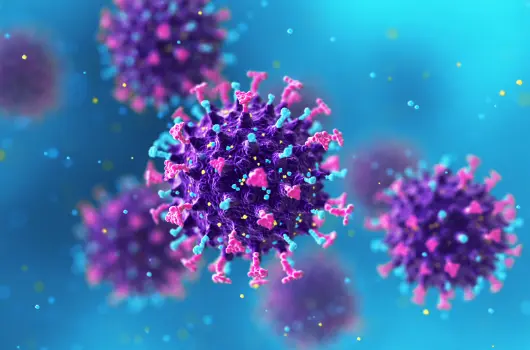Clinical Study
PCR Testing: A Game-Changer for Women’s Gynecologic Health

HealthTrackRx Clinical Team • Nov. 4, 2024
A new study published in Population Health Management demonstrates the benefits of using PCR (polymerase chain reaction) testing for women’s gynecologic health, particularly for diagnosing vaginitis and vaginosis. This study, which used data from over 200,000 women in the Merative MarketScan database, shows that those who received PCR testing for these conditions had lower healthcare costs over the 12 weeks following their diagnosis compared to women diagnosed with clinical methods alone.
Historically, limited diagnostic tools have led to incorrect treatment and higher recurrence rates in nearly half of women with vaginitis. This study is the first of its kind to highlight the real-world cost benefits of PCR testing, supporting current guidelines that recommend molecular testing for accurate diagnosis. Overall, the findings underscore how advanced diagnostics in women’s health can lead to more effective care and cost savings for patients, providers, and payers.
The Problem
Vaginitis is a leading cause of outpatient healthcare visits among women, contributing to an estimated $24 million to $15 billion in healthcare costs annually[1-4]. The primary causes of vaginitis include bacterial vaginosis, candidiasis, and trichomoniasis, however due the overlap in clinical presentation with sexually transmitted infections, accurate diagnosis based on clinical presentation alone can be challenging[5, 6]. Previous studies have found that empiric diagnosis in the community practice setting is inaccurate as frequently as 42% of the time[7].
The high economic burden of vaginitis is attributed to the high rate of recurrence of these infections, most notably bacterial vaginosis which has been estimated to be as high as 80%[8]. Although treatable, bacterial vaginosis has been documented to increase risk of susceptibility to other sexually transmitted infections, pelvic inflammatory disease, preterm labor, and even infertility[9].
The Solution
Advancements in molecular diagnostic technology have made it easier to accurately diagnose both the traditional causes of vaginitis, as well as sexually transmitted infections with similar symptoms[10]. These tests offer substantial workflow efficiencies for clinics over traditional diagnostic methods like wet mount microscopy, KOH preps, and Amsel criteria[11-13]. However, with the broader adoption of molecular diagnostics, it becomes essential to assess the impact of these tests on follow-up healthcare costs.
The Research Study
This study analyzed the follow-up healthcare costs of patients receiving any PCR test for a diagnosis of vaginitis to patients who were diagnosed with Amsel criteria or empiric diagnosis alone[14]. Using the 2021 MarketScan database by Merative, follow-up healthcare claims were assessed over 12-weeks following the initial patient diagnosis. Findings from this study indicate that those patients who received a PCR test had lower total healthcare costs over the 12-week follow-up period. Total per member per month costs over the 12-week period for the PCR group were $424.92, while the group that were diagnosed via Amsel criteria was $459.23, and the empiric diagnosis group costs were $672.78.
Conclusion
Our research shows that faster and more targeted clinical decisions enabled by PCR testing can improve women’s health care through lower follow-up costs of care as compared to other diagnostic approaches.
Read more about our findings from this study that was published in Population Health Management.
References
- Peebles, K., et al., High Global Burden and Costs of Bacterial Vaginosis: A Systematic Review and Meta-Analysis. Sexually Transmitted Diseases, 2019. 46(5).
- Kumar, S., H. Chesson, and T.L. Gift, Estimating the Direct Medical Outpatient Costs of Diagnosis and Treatment of Trichomoniasis Among Commercially Insured Patients in the United States, 2016 to 2018. Sexually Transmitted Diseases, 2021. 48(3): p. E45-E47.
- Watkins, E., et al., Treatment patterns and economic burden of bacterial vaginosis among commercially insured women in the USA. Journal of Comparative Effectiveness Research, 2024. 13(1).
- Denning, D.W., et al., Global burden of recurrent vulvovaginal candidiasis: a systematic review. The Lancet Infectious Diseases, 2018. 18(11): p. e339-e347.
- Paladine, H.L. and U.A. Desai, Vaginitis: Diagnosis and Treatment. Am Fam Physician, 2018. 97(5): p. 321-329.
- Kent, H.L., Epidemiology of vaginitis. American Journal of Obstetrics & Gynecology, 1991. 165(4): p. 1168-1176.
- Hillier, S.L., et al., Diagnosis and Treatment of Vaginal Discharge Syndromes in Community Practice Settings. Clinical Infectious Diseases, 2021. 72(9): p. 1538-1543.
- Muzny, C.A. and J.D. Sobel, Understanding and Preventing Recurring Bacterial Vaginosis: Important Considerations for Clinicians, in International Journal of Women’s Health. 2023, Dove Medical Press Ltd. p. 1317-1325.
- Bautista, C.T., et al., Bacterial vaginosis: a synthesis of the literature on etiology, prevalence, risk factors, and relationship with chlamydia and gonorrhea infections. Military Medical Research, 2016. 3(1).
- Miller, J.M., et al., Guide to Utilization of the Microbiology Laboratory for Diagnosis of Infectious Diseases: 2024 Update by the Infectious Diseases Society of America (IDSA) and the American Society for Microbiology (ASM). Clinical Infectious Diseases, 2024.
- Lillis, R.A., et al., Clinical Evaluation of a New Molecular Test for the Detection of Organisms Causing Vaginitis and Vaginosis. Journal of clinical microbiology, 2023. 61(3): p. e0174822-e0174822.
- Fredricks, D.N. and D.A. Relman, Application of Polymerase Chain Reaction to the Diagnosis of Application of Polymerase Chain Reaction to the Diagnosis of Infectious Diseases Infectious Diseases. 1999.
- Broache, M., et al., Performance of a Vaginal Panel Assay Compared With the Clinical Diagnosis of Vaginitis. Obstetrics & Gynecology, 2021. 138(6): p. 853-859.
- Evans, A., et al., Molecular Testing for Women’s Gynecologic Health: Real-World Impact on Health Care Costs. Population Health Management, 2024-09-25.
References
- Peebles, K., et al., High Global Burden and Costs of Bacterial Vaginosis: A Systematic Review and Meta-Analysis. Sexually Transmitted Diseases, 2019. 46(5).
- Kumar, S., H. Chesson, and T.L. Gift, Estimating the Direct Medical Outpatient Costs of Diagnosis and Treatment of Trichomoniasis Among Commercially Insured Patients in the United States, 2016 to 2018. Sexually Transmitted Diseases, 2021. 48(3): p. E45-E47.
- Watkins, E., et al., Treatment patterns and economic burden of bacterial vaginosis among commercially insured women in the USA. Journal of Comparative Effectiveness Research, 2024. 13(1).
- Denning, D.W., et al., Global burden of recurrent vulvovaginal candidiasis: a systematic review. The Lancet Infectious Diseases, 2018. 18(11): p. e339-e347.
- Paladine, H.L. and U.A. Desai, Vaginitis: Diagnosis and Treatment. Am Fam Physician, 2018. 97(5): p. 321-329.
- Kent, H.L., Epidemiology of vaginitis. American Journal of Obstetrics & Gynecology, 1991. 165(4): p. 1168-1176.
- Hillier, S.L., et al., Diagnosis and Treatment of Vaginal Discharge Syndromes in Community Practice Settings. Clinical Infectious Diseases, 2021. 72(9): p. 1538-1543.
- Muzny, C.A. and J.D. Sobel, Understanding and Preventing Recurring Bacterial Vaginosis: Important Considerations for Clinicians, in International Journal of Women’s Health. 2023, Dove Medical Press Ltd. p. 1317-1325.
- Bautista, C.T., et al., Bacterial vaginosis: a synthesis of the literature on etiology, prevalence, risk factors, and relationship with chlamydia and gonorrhea infections. Military Medical Research, 2016. 3(1).
- Miller, J.M., et al., Guide to Utilization of the Microbiology Laboratory for Diagnosis of Infectious Diseases: 2024 Update by the Infectious Diseases Society of America (IDSA) and the American Society for Microbiology (ASM). Clinical Infectious Diseases, 2024.
- Lillis, R.A., et al., Clinical Evaluation of a New Molecular Test for the Detection of Organisms Causing Vaginitis and Vaginosis. Journal of clinical microbiology, 2023. 61(3): p. e0174822-e0174822.
- Fredricks, D.N. and D.A. Relman, Application of Polymerase Chain Reaction to the Diagnosis of Application of Polymerase Chain Reaction to the Diagnosis of Infectious Diseases Infectious Diseases. 1999.
- Broache, M., et al., Performance of a Vaginal Panel Assay Compared With the Clinical Diagnosis of Vaginitis. Obstetrics & Gynecology, 2021. 138(6): p. 853-859.
- Evans, A., et al., Molecular Testing for Women’s Gynecologic Health: Real-World Impact on Health Care Costs. Population Health Management, 2024-09-25.
Related Articles and White papers

HealthTrackRx Clinical Team • Nov. 4, 2024
A new study published in Population Health Management demonstrates the benefits of using PCR (polymerase chain reaction) testing for women’s gynecologic health, particularly for diagnosing vaginitis and vaginosis. This study, which used data from over 200,000 women in the Merative MarketScan database, shows that those who received PCR testing for these conditions had lower healthcare costs over the 12 weeks following their diagnosis compared to women diagnosed with clinical methods alone.
Historically, limited diagnostic tools have led to incorrect treatment and higher recurrence rates in nearly half of women with vaginitis. This study is the first of its kind to highlight the real-world cost benefits of PCR testing, supporting current guidelines that recommend molecular testing for accurate diagnosis. Overall, the findings underscore how advanced diagnostics in women’s health can lead to more effective care and cost savings for patients, providers, and payers.
The Problem
Vaginitis is a leading cause of outpatient healthcare visits among women, contributing to an estimated $24 million to $15 billion in healthcare costs annually[1-4]. The primary causes of vaginitis include bacterial vaginosis, candidiasis, and trichomoniasis, however due the overlap in clinical presentation with sexually transmitted infections, accurate diagnosis based on clinical presentation alone can be challenging[5, 6]. Previous studies have found that empiric diagnosis in the community practice setting is inaccurate as frequently as 42% of the time[7].
The high economic burden of vaginitis is attributed to the high rate of recurrence of these infections, most notably bacterial vaginosis which has been estimated to be as high as 80%[8]. Although treatable, bacterial vaginosis has been documented to increase risk of susceptibility to other sexually transmitted infections, pelvic inflammatory disease, preterm labor, and even infertility[9].
The Solution
Advancements in molecular diagnostic technology have made it easier to accurately diagnose both the traditional causes of vaginitis, as well as sexually transmitted infections with similar symptoms[10]. These tests offer substantial workflow efficiencies for clinics over traditional diagnostic methods like wet mount microscopy, KOH preps, and Amsel criteria[11-13]. However, with the broader adoption of molecular diagnostics, it becomes essential to assess the impact of these tests on follow-up healthcare costs.
The Research Study
This study analyzed the follow-up healthcare costs of patients receiving any PCR test for a diagnosis of vaginitis to patients who were diagnosed with Amsel criteria or empiric diagnosis alone[14]. Using the 2021 MarketScan database by Merative, follow-up healthcare claims were assessed over 12-weeks following the initial patient diagnosis. Findings from this study indicate that those patients who received a PCR test had lower total healthcare costs over the 12-week follow-up period. Total per member per month costs over the 12-week period for the PCR group were $424.92, while the group that were diagnosed via Amsel criteria was $459.23, and the empiric diagnosis group costs were $672.78.
Conclusion
Our research shows that faster and more targeted clinical decisions enabled by PCR testing can improve women’s health care through lower follow-up costs of care as compared to other diagnostic approaches.
Read more about our findings from this study that was published in Population Health Management.
References
- Peebles, K., et al., High Global Burden and Costs of Bacterial Vaginosis: A Systematic Review and Meta-Analysis. Sexually Transmitted Diseases, 2019. 46(5).
- Kumar, S., H. Chesson, and T.L. Gift, Estimating the Direct Medical Outpatient Costs of Diagnosis and Treatment of Trichomoniasis Among Commercially Insured Patients in the United States, 2016 to 2018. Sexually Transmitted Diseases, 2021. 48(3): p. E45-E47.
- Watkins, E., et al., Treatment patterns and economic burden of bacterial vaginosis among commercially insured women in the USA. Journal of Comparative Effectiveness Research, 2024. 13(1).
- Denning, D.W., et al., Global burden of recurrent vulvovaginal candidiasis: a systematic review. The Lancet Infectious Diseases, 2018. 18(11): p. e339-e347.
- Paladine, H.L. and U.A. Desai, Vaginitis: Diagnosis and Treatment. Am Fam Physician, 2018. 97(5): p. 321-329.
- Kent, H.L., Epidemiology of vaginitis. American Journal of Obstetrics & Gynecology, 1991. 165(4): p. 1168-1176.
- Hillier, S.L., et al., Diagnosis and Treatment of Vaginal Discharge Syndromes in Community Practice Settings. Clinical Infectious Diseases, 2021. 72(9): p. 1538-1543.
- Muzny, C.A. and J.D. Sobel, Understanding and Preventing Recurring Bacterial Vaginosis: Important Considerations for Clinicians, in International Journal of Women’s Health. 2023, Dove Medical Press Ltd. p. 1317-1325.
- Bautista, C.T., et al., Bacterial vaginosis: a synthesis of the literature on etiology, prevalence, risk factors, and relationship with chlamydia and gonorrhea infections. Military Medical Research, 2016. 3(1).
- Miller, J.M., et al., Guide to Utilization of the Microbiology Laboratory for Diagnosis of Infectious Diseases: 2024 Update by the Infectious Diseases Society of America (IDSA) and the American Society for Microbiology (ASM). Clinical Infectious Diseases, 2024.
- Lillis, R.A., et al., Clinical Evaluation of a New Molecular Test for the Detection of Organisms Causing Vaginitis and Vaginosis. Journal of clinical microbiology, 2023. 61(3): p. e0174822-e0174822.
- Fredricks, D.N. and D.A. Relman, Application of Polymerase Chain Reaction to the Diagnosis of Application of Polymerase Chain Reaction to the Diagnosis of Infectious Diseases Infectious Diseases. 1999.
- Broache, M., et al., Performance of a Vaginal Panel Assay Compared With the Clinical Diagnosis of Vaginitis. Obstetrics & Gynecology, 2021. 138(6): p. 853-859.
- Evans, A., et al., Molecular Testing for Women’s Gynecologic Health: Real-World Impact on Health Care Costs. Population Health Management, 2024-09-25.
References
- Peebles, K., et al., High Global Burden and Costs of Bacterial Vaginosis: A Systematic Review and Meta-Analysis. Sexually Transmitted Diseases, 2019. 46(5).
- Kumar, S., H. Chesson, and T.L. Gift, Estimating the Direct Medical Outpatient Costs of Diagnosis and Treatment of Trichomoniasis Among Commercially Insured Patients in the United States, 2016 to 2018. Sexually Transmitted Diseases, 2021. 48(3): p. E45-E47.
- Watkins, E., et al., Treatment patterns and economic burden of bacterial vaginosis among commercially insured women in the USA. Journal of Comparative Effectiveness Research, 2024. 13(1).
- Denning, D.W., et al., Global burden of recurrent vulvovaginal candidiasis: a systematic review. The Lancet Infectious Diseases, 2018. 18(11): p. e339-e347.
- Paladine, H.L. and U.A. Desai, Vaginitis: Diagnosis and Treatment. Am Fam Physician, 2018. 97(5): p. 321-329.
- Kent, H.L., Epidemiology of vaginitis. American Journal of Obstetrics & Gynecology, 1991. 165(4): p. 1168-1176.
- Hillier, S.L., et al., Diagnosis and Treatment of Vaginal Discharge Syndromes in Community Practice Settings. Clinical Infectious Diseases, 2021. 72(9): p. 1538-1543.
- Muzny, C.A. and J.D. Sobel, Understanding and Preventing Recurring Bacterial Vaginosis: Important Considerations for Clinicians, in International Journal of Women’s Health. 2023, Dove Medical Press Ltd. p. 1317-1325.
- Bautista, C.T., et al., Bacterial vaginosis: a synthesis of the literature on etiology, prevalence, risk factors, and relationship with chlamydia and gonorrhea infections. Military Medical Research, 2016. 3(1).
- Miller, J.M., et al., Guide to Utilization of the Microbiology Laboratory for Diagnosis of Infectious Diseases: 2024 Update by the Infectious Diseases Society of America (IDSA) and the American Society for Microbiology (ASM). Clinical Infectious Diseases, 2024.
- Lillis, R.A., et al., Clinical Evaluation of a New Molecular Test for the Detection of Organisms Causing Vaginitis and Vaginosis. Journal of clinical microbiology, 2023. 61(3): p. e0174822-e0174822.
- Fredricks, D.N. and D.A. Relman, Application of Polymerase Chain Reaction to the Diagnosis of Application of Polymerase Chain Reaction to the Diagnosis of Infectious Diseases Infectious Diseases. 1999.
- Broache, M., et al., Performance of a Vaginal Panel Assay Compared With the Clinical Diagnosis of Vaginitis. Obstetrics & Gynecology, 2021. 138(6): p. 853-859.
- Evans, A., et al., Molecular Testing for Women’s Gynecologic Health: Real-World Impact on Health Care Costs. Population Health Management, 2024-09-25.





